Key takeaways
- Peak Design bags feature a sleek design with modular interiors and comfortable ergonomic features for easy customization and reduced strain during long shoots.
- The innovative MagLatch system allows for quick, one-handed access to gear, enhancing responsiveness during fast-paced shooting situations.
- Weatherproof construction ensures durability and protection for equipment in various environmental conditions, providing peace of mind for photographers on the go.
- Careful organization and intuitive layouts help photographers access gear quickly, minimizing downtime and maximizing shooting opportunities.
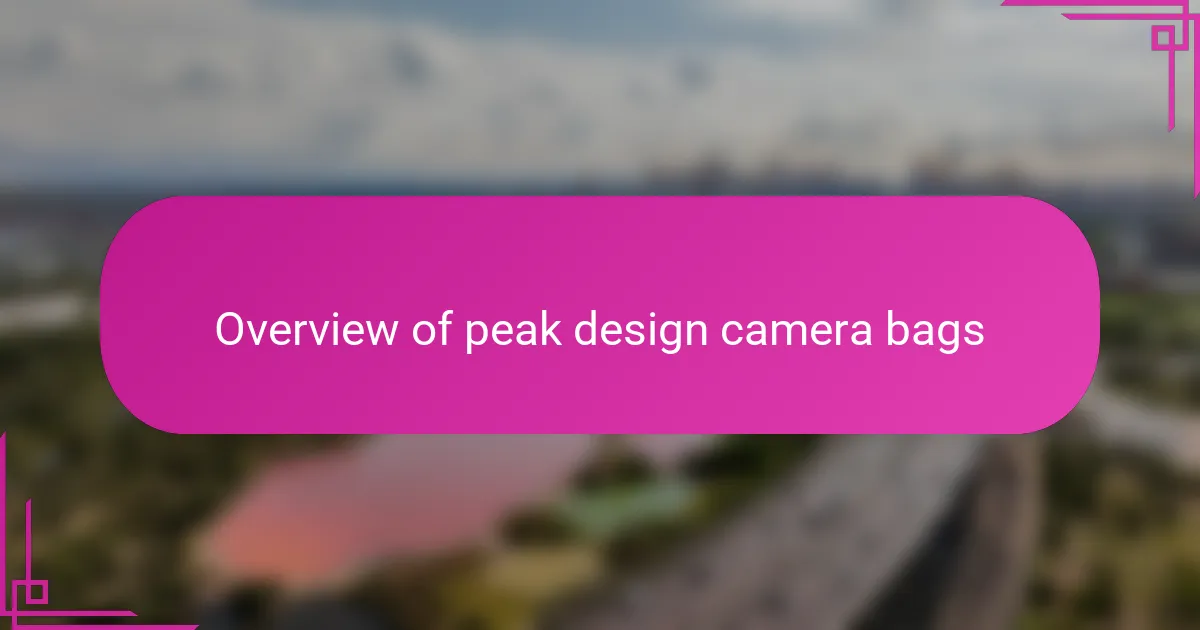
Overview of peak design camera bags
Peak Design camera bags stand out to me for their sleek, minimalist design paired with impressive functionality. I remember the first time I unpacked one—I was struck by how thoughtfully every pocket and strap seemed designed to anticipate my needs as a photographer.
What really sets these bags apart is their modularity. Have you ever wished your bag could transform based on your shoot? With Peak Design, you can customize internal compartments on the fly, which felt like a game-changer during a busy day of shooting.
Their materials also give an immediate sense of durability without bulk. I’ve brought my bag through rain, crowded streets, and hectic travel days, and it’s held up impressively well—making me feel confident that my gear is truly protected.
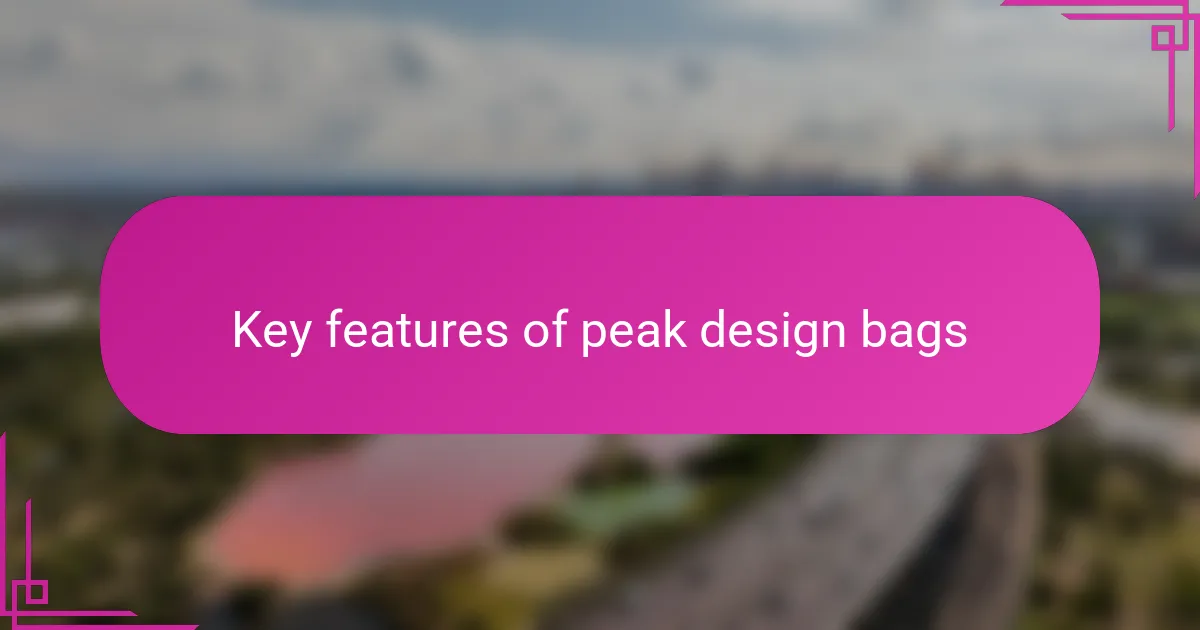
Key features of peak design bags
One feature that instantly caught my attention is the innovative MagLatch system. It offers quick, one-handed access to the main compartment, which felt like a small but significant convenience during tight, fast-paced shoots. Have you ever fumbled with zippers when a perfect shot appears unexpectedly? This feature definitely saved me from missing moments.
Another standout aspect is the weatherproof construction. I once found myself caught in a sudden downpour, and instead of worrying about my gear, I trusted Peak Design’s durable, water-resistant materials. That peace of mind is priceless, especially when you’re miles away from home and shooting in unpredictable conditions.
Lastly, the ergonomic design truly considers the photographer’s comfort during long hours. The padded straps and the bag’s balanced weight distribution made carrying heavy equipment less of a chore. I’ve learned that when your gear feels lighter on your shoulders, your focus on the creative process sharpens remarkably.
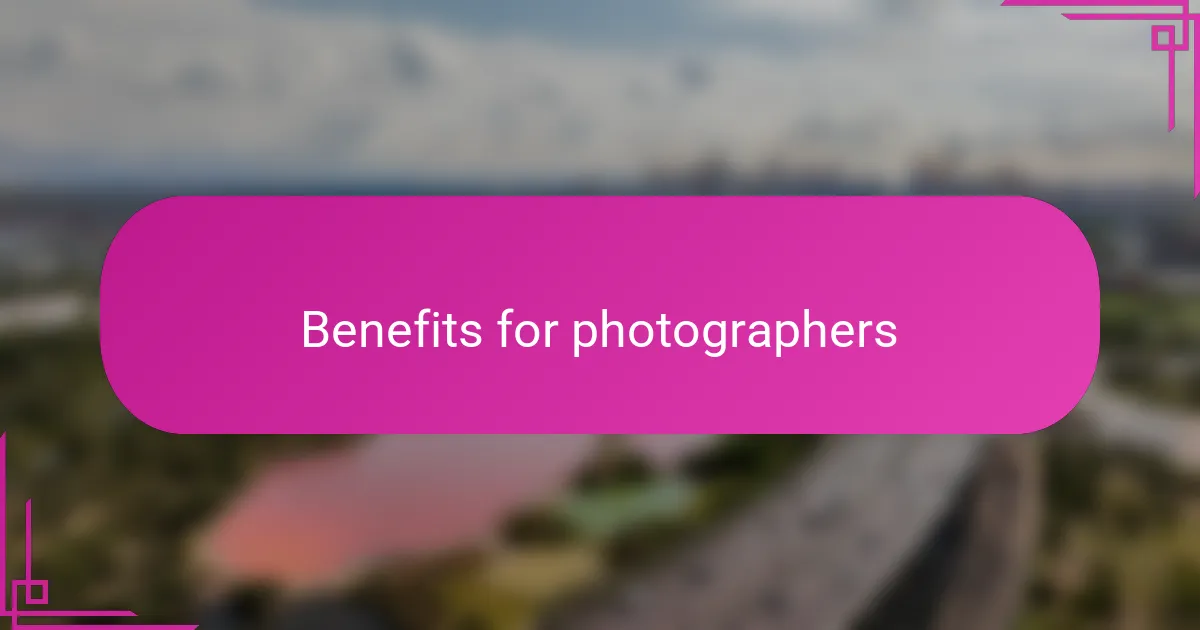
Benefits for photographers
One of the biggest benefits I’ve noticed with Peak Design bags is how they keep me organized without slowing me down. Have you ever scrambled to find that one lens cap or spare battery in a jumbled bag? With Peak Design, every pocket and divider has a purpose, so I spend less time digging and more time shooting.
Another advantage is the seamless blend of protection and accessibility. I’ve had moments when I needed to switch lenses quickly during a golden hour shoot, and the bag’s layout made it easy to grab what I needed without fumbling. That balance between security and speed is something I didn’t expect but now can’t live without.
Finally, carrying my gear feels surprisingly effortless, even after hours on the move. The ergonomic design reduces shoulder strain in a way I hadn’t anticipated. When fatigue isn’t distracting me, I find myself more present and creative behind the camera, which makes a huge difference in the quality of my work.
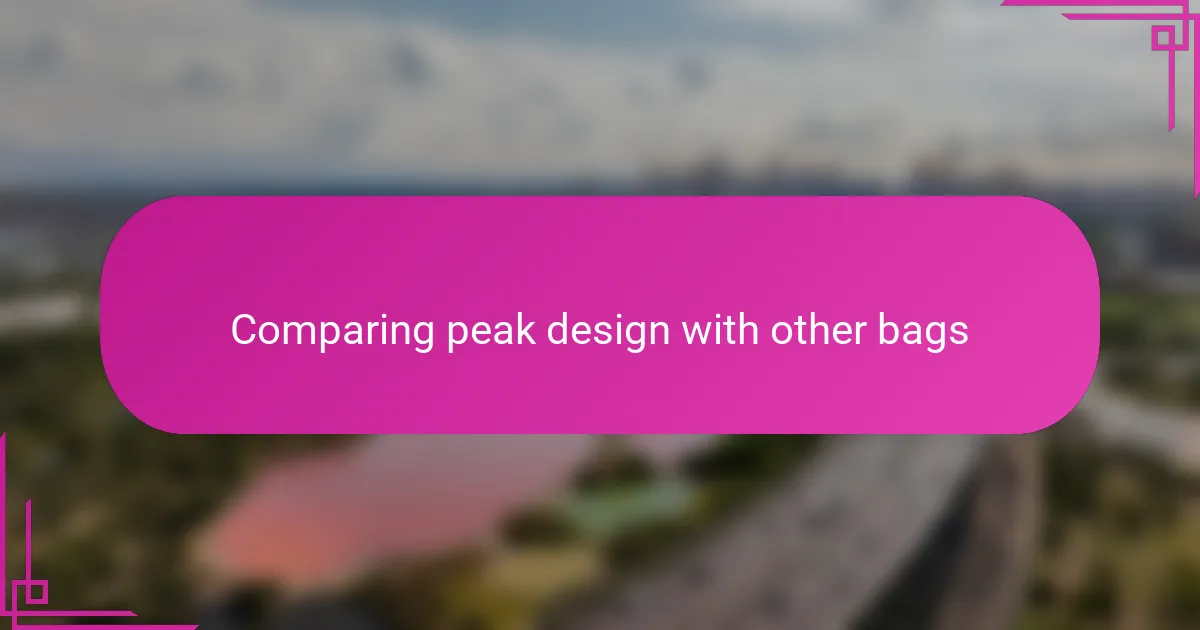
Comparing peak design with other bags
When I first compared my Peak Design bag to others I’d used, the difference in build quality was immediately noticeable. While some bags felt bulky or cheaply made, Peak Design struck a perfect balance between ruggedness and sleekness, making it easier to carry all day without feeling weighed down. Have you ever carried a camera bag that felt like a burden before you even started shooting? That’s exactly the feeling Peak Design avoids.
Another thing I noticed was how many other bags lacked the modular flexibility I now take for granted. I used to struggle when trying to rearrange compartments in traditional bags, often resorting to bulky inserts or external pouches. With Peak Design, adjusting the dividers is simple and intuitive, and that’s been a real time saver during back-to-back shoots where gear needs change constantly.
Lastly, the access system made a surprising difference compared to typical zipper-heavy bags. I’ve had so many moments with other bags where I accidentally fumbling with zippers caused me to miss a shot, especially in low light or crowded settings. Using the MagLatch on my Peak Design bag felt like a small upgrade that made a huge difference in keeping me ready and responsive. Wouldn’t you agree that quick gear access is critical when seconds count?
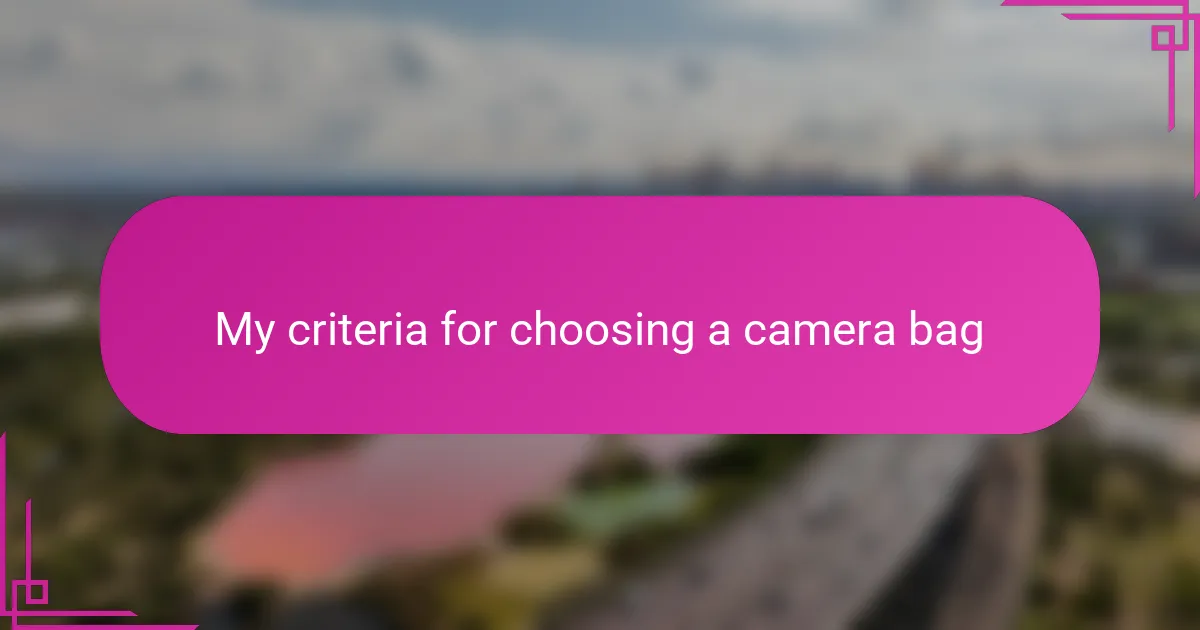
My criteria for choosing a camera bag
For me, the first thing I look for in a camera bag is how well it protects my equipment without adding unnecessary weight. Have you ever felt like your bag was as heavy as your gear? That constant shoulder ache was a dealbreaker until I found bags that balance durability with lightness.
Organization is another non-negotiable. I’ve wasted too many moments digging through cluttered compartments when every second counts. I want a bag that feels intuitive—where every pocket and divider has a clear purpose, so I can stay focused on capturing the shot instead of searching for my lens.
Comfort also ranks high on my list. When you’re out shooting for hours, a bag that digs into your shoulders or throws off your posture can turn an exciting shoot into a struggle. I value features like padded straps and balanced weight distribution because they let me carry what I need without sacrificing energy or enthusiasm.
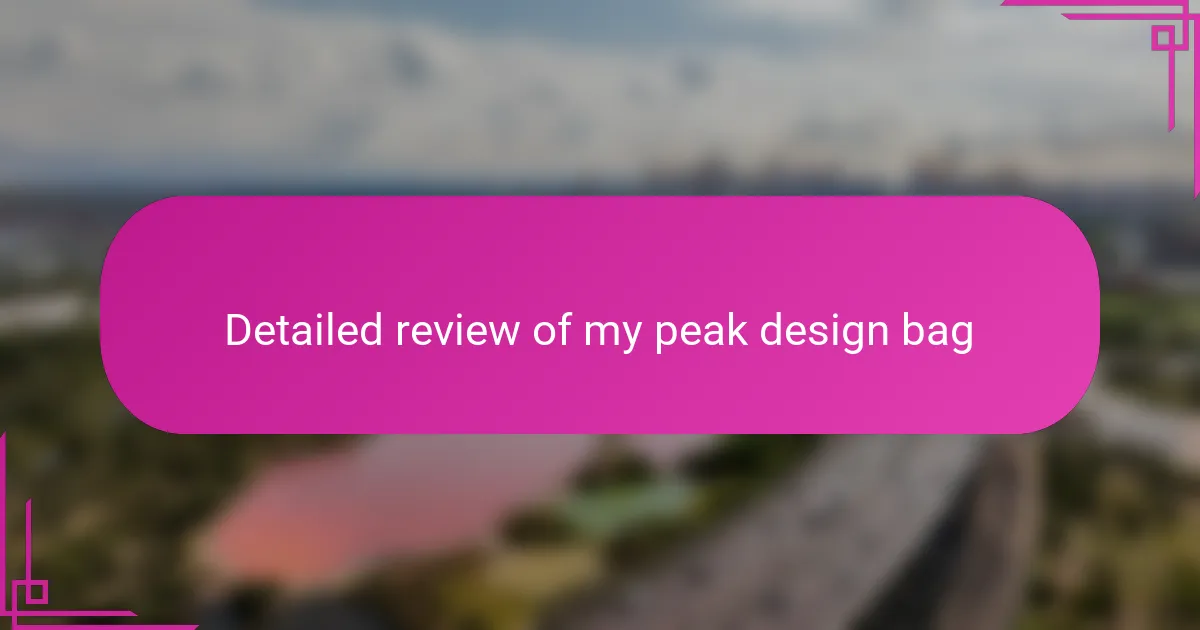
Detailed review of my peak design bag
The first time I loaded up my Peak Design bag for a full-day shoot, I was genuinely impressed by the intuitive layout. Each compartment seemed thoughtfully placed, making it easy to grab my lens or batteries without pausing to dig around. Have you ever had a shoot where every second counts? This bag definitely helped me stay in the moment rather than fumbling through gear.
What surprised me most was how the materials held up under tough conditions. I recall a windy, rainy afternoon when my bag protected not only my camera but also my laptop and documents without a single drop getting inside. That kind of durability gave me peace of mind—something I didn’t expect but came to deeply appreciate.
One aspect I keep coming back to is the bag’s comfort. After hours of walking between locations, the padded straps and thoughtful weight distribution made the difference between fatigue and sustained energy. Isn’t it amazing how something as simple as a well-designed strap can turn a grueling day into an enjoyable adventure? That’s the kind of subtle but impactful design I value most.

Tips for getting the most from peak design bags
One tip I’ve found invaluable is to fully embrace the modular dividers. At first, I underestimated how much customizing the layout would improve my workflow. But once I started tailoring the compartments to fit my specific gear for each shoot, I noticed a big difference in how quickly I could pack and access everything. Have you ever tried rearranging your bag to fit a new lens or accessory? It’s surprisingly satisfying and keeps you organized on the go.
Another thing that helped me was learning to use the MagLatch system confidently. It feels a bit unusual at first, especially if you’re used to zippers, but once you get the hang of it, accessing your gear becomes second nature. I caught myself reaching for my bag with one hand during a street shoot without missing a beat—that quick access really saved me from losing moments worth capturing.
Finally, don’t overlook how adjusting the strap length and padding can change your comfort level. I used to ignore this step and ended up with a sore shoulder after long days out. Taking a few minutes to fine-tune the fit made carrying heavy gear feel almost effortless. Trust me, when your bag feels comfortable, your focus stays sharper and your creative energy lasts longer. Have you noticed how comfort affects your shooting stamina? I definitely have.